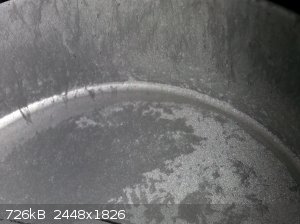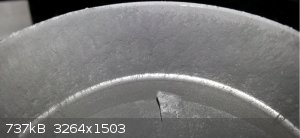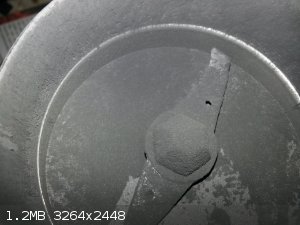RogueRose
International Hazard
    
Posts: 1593
Registered: 16-6-2014
Member Is Offline
|
|
Al powder - strange reaction when grinding in coffee grinder
So I milled in a ball mill for a few days then I sifted into 5 different fineness and took the most fine (which could pass through a nylon coffee
filter - probably about 1/6 - 1/5 of a mm^2 so pretty fine) sifting and put it in the coffee grinder. After a few grindings (went until it was too
hot) I waited for 10 minutes and opened. There was a BLACK layer on top, a fine dusting, and a very beautiful silver underneath.
The Al before grinding was grey, not shiny - after grinding it was like polished Al/silver. The dust layer was totally black and SUPER fine (much
more than the silver - it was like Ash fineness).
I shook the grinder and mixed everything and allowed the Al to sit for a few hours and it looked the same (no change) after that time.
How did the black happen so quickly? I suspect it was Al2O3. I expected it to form on the newly ground Al but it isn't happening.
|
|
|
SWIM
National Hazard
   
Posts: 970
Registered: 3-9-2017
Member Is Offline
|
|
They sell an aluminum powder for pyrotechnics called blackhead powder, which looks pretty black in the photos on the sites that sell it.
I don't know if it's possible that you managed to make a little of something like that.
I'm not even sure why that stuff IS black, but maybe one of the energetic materials buffs on here can comment.
@elementcollector1, thanks for explaining what was a mystery to me.
[Edited on 8-9-2017 by SWIM]
[Edited on 8-9-2017 by SWIM]
|
|
|
hissingnoise
International Hazard
    
Posts: 3940
Registered: 26-12-2002
Member Is Offline
Mood: Pulverulescent!
|
|
What did you mill, exactly ─ chunks or foil?
|
|
|
XeonTheMGPony
International Hazard
    
Posts: 1640
Registered: 5-1-2016
Member Is Offline
Mood: No Mood
|
|
the black is carbon it is used to lubricate the flakes and to slightly reduce oxidation during storage by creating a protective coat on the flake.
In this case most likely oxid and some plastic dust from the grinder.
|
|
|
elementcollector1
International Hazard
    
Posts: 2684
Registered: 28-12-2011
Location: The Known Universe
Member Is Offline
Mood: Molten
|
|
It's black due to light scattering. Same reason salt crystals are white when they're small and transparent when they're big.
Elements Collected:52/87
Latest Acquired: Cl
Next in Line: Nd
|
|
|
Bert
Super Administrator
        
Posts: 2821
Registered: 12-3-2004
Member Is Offline
Mood: " I think we are all going to die. I think that love is an illusion. We are flawed, my darling".
|
|
Yup. The old American dark Aluminum was not dark from carbon left over from processing, as some German and Indian flash Aluminums are. Looked dark due
to particle size. Ah, memories. Why is this flash powder BLACK, not SILVER?!
So, unless the ball mill, media or coffee grinder have black material you ground off? You may well have produced some % of a very fine Aluminum powder
along with a larger portion of coarser "bright" Aluminum.
If you can separate the fines, try mixing a SMALL amount at 30% with perchlorate 70%, and roll up a small firecracker for a test shot- You know you
want to...
Rapopart’s Rules for critical commentary:
1. Attempt to re-express your target’s position so clearly, vividly and fairly that your target says: “Thanks, I wish I’d thought of putting it
that way.”
2. List any points of agreement (especially if they are not matters of general or widespread agreement).
3. Mention anything you have learned from your target.
4. Only then are you permitted to say so much as a word of rebuttal or criticism.
Anatol Rapoport was a Russian-born American mathematical psychologist (1911-2007).
|
|
|
RogueRose
International Hazard
    
Posts: 1593
Registered: 16-6-2014
Member Is Offline
|
|
Well the source is Al foil (generic store brand) and used hardened steel bearings and large ceramic insulators (40x size of bearings) inside a steel
container. There is some abrasion in the container but not a lot.
When I take the lid off the grinder, I can see what looks like "cob webs" in the black material, especially on the sides of the container and on the
central plastic nut of the blade.
I've checked abrasion and the only thing that is black and plastic is the central nut on the blade and it still looks the same with the same texture
as before and I've collected about 5g+ of this black super fine dust (it really sticks to the lid, luckily).
The cob web thing is kind of strange.
  
EDIT: Now that I look at the color with the flash from this pic, the color is much more grey than black. I was looking at it was a different light
before (in a dark room using a flash light) and it was very much black. These pics are a combo of natural light and the camera flash.
[Edited on 9-9-2017 by RogueRose]
|
|
|
hissingnoise
International Hazard
    
Posts: 3940
Registered: 26-12-2002
Member Is Offline
Mood: Pulverulescent!
|
|
Quote: Originally posted by RogueRose  | | Well the source is Al foil (generic store brand) and used hardened steel bearings and large ceramic insulators (40x size of bearings) inside a steel
container. |
Most alufoil has a thin coating of polymer on its shiny side and this might account for some powdering...
BTW, hardened lead media in a grounded PVC container is safer than steel, IMO, for grinding Al since you don't need rust traces rattling around in
there.
|
|
|